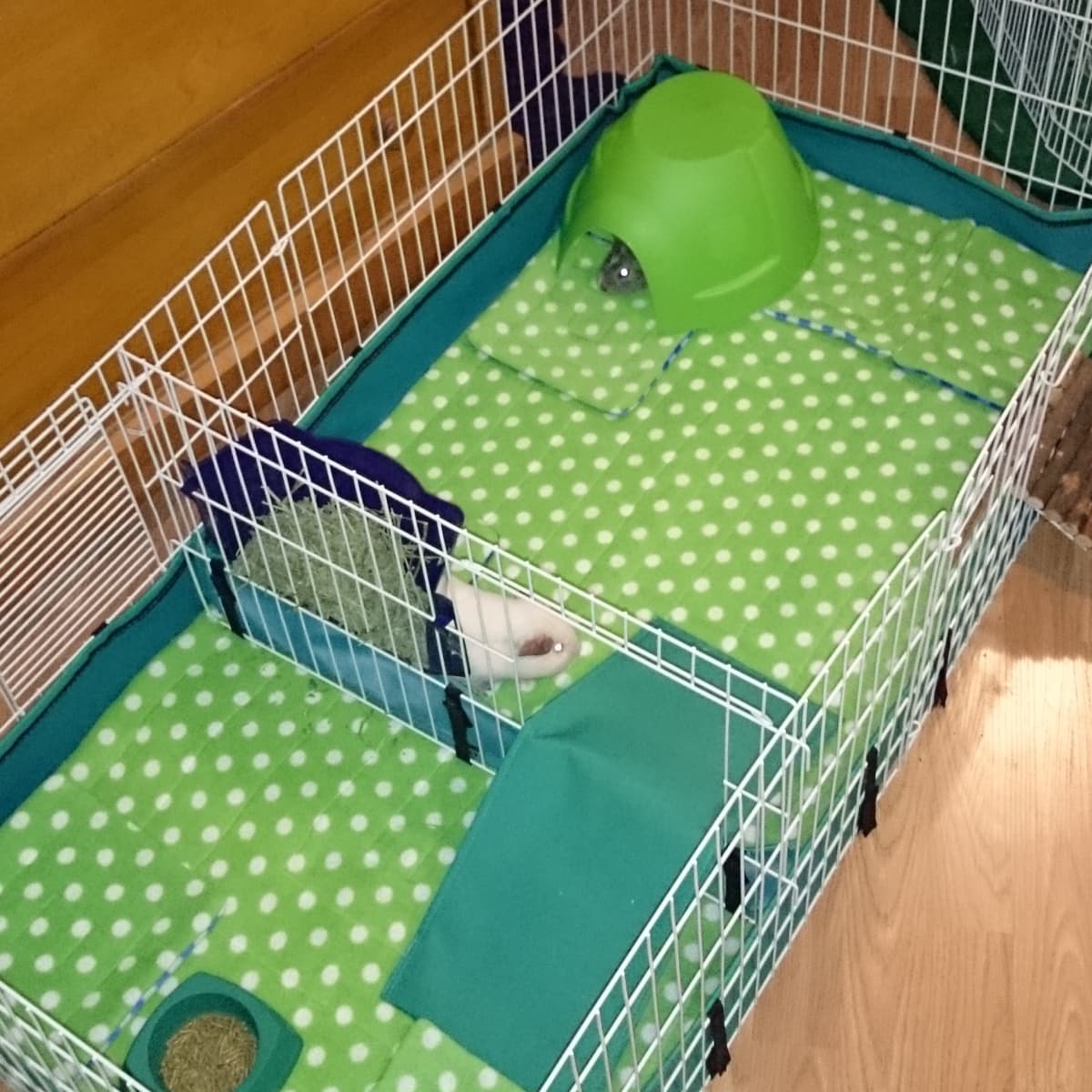Create DIY guinea pig bedding by using materials like fleece, towels, or shredded paper for a cozy and safe habitat. Customize the bedding with patterns, colors, and textures to suit your pet’s preferences and needs.
Making homemade bedding for your guinea pig is a fun and cost-effective way to ensure their comfort and well-being. By following some simple tips and tricks, you can create a personalized bedding solution that your furry friend will love. Let’s explore how to make homemade guinea pig bedding and discover creative ideas for customization to enhance your pet’s living environment.
Contents
- Introduction To Diy Guinea Pig Bedding
- Materials Needed For Homemade Bedding
- Step-by-step Guide To Creating Fleece Bedding
- Paper-based Bedding Solutions
- Customizing Your Guinea Pig’s Sleep Area
- Cleaning And Maintenance
- Health And Safety Considerations
- Community Tips And Tricks
- Frequently Asked Questions
- Conclusion
Introduction To Diy Guinea Pig Bedding
Discover the art of creating DIY Guinea Pig Bedding at home with personalized touches for your furry friends. Learn how to craft homemade bedding that suits your guinea pigs’ needs and preferences, ensuring a cozy and comfortable environment for them to enjoy.
Guinea pigs are adorable and low-maintenance pets that require a comfortable and clean living environment. One essential aspect of their habitat is bedding. While there are various options available in pet stores, making your own DIY guinea pig bedding can be a cost-effective and customizable solution. In this article, we will explore the reasons why homemade bedding is a great choice for your furry friend and provide you with tips for customization.
Why Choose Homemade Bedding?
Homemade bedding offers several advantages over store-bought alternatives. Firstly, it allows you to have complete control over the materials used, ensuring the safety and well-being of your guinea pig. Additionally, DIY bedding can be more affordable in the long run, as you can often find suitable materials around your home. By opting for homemade bedding, you also contribute to reducing waste and promoting eco-friendly practices.
Benefits For Your Guinea Pig
Using homemade bedding can greatly benefit your guinea pig’s health and comfort. Natural materials such as hay, shredded paper, or fleece provide a soft and cozy surface for your pet to rest on. They also absorb moisture effectively, helping to keep the cage clean and odor-free. Moreover, DIY bedding allows for customization based on your guinea pig’s specific needs. You can adjust the thickness, texture, and even add herbs or aromatics to enhance their sensory experience.

Credit: pethelpful.com
Materials Needed For Homemade Bedding
When it comes to creating homemade bedding for your guinea pig, it’s important to choose safe materials that provide comfort and hygiene. By customizing the bedding, you can ensure that it meets your pet’s specific needs. Here’s a guide to the materials needed for homemade bedding and tips for customization.
Safe Materials
Fleece: Soft and washable material that provides comfort for your guinea pig.
Paper-based beddings: Environmentally friendly and absorbent options such as paper pellets or shredded paper.
Hay: A natural and cozy bedding option that also encourages foraging behavior.
Materials To Avoid
Cedar and pine wood shavings: These can release harmful aromatic oils and dust.
Cat litter: Contains chemicals that can be harmful to guinea pigs if ingested.
Corn cob bedding: May harbor bacteria and mold, posing health risks to guinea pigs.
Step-by-step Guide To Creating Fleece Bedding
When it comes to providing your guinea pig with a comfortable and safe living environment, the bedding you choose plays a crucial role. Making your own fleece bedding can be a cost-effective and customizable option. Here’s a step-by-step guide to creating fleece bedding for your furry friend, along with tips for customization and maintenance.
Preparing The Fleece
Before you start making your fleece bedding, it’s important to prepare the fleece fabric. Wash and dry the fleece to remove any residues and ensure it is clean and safe for your guinea pig.
Layering For Absorption
When creating fleece bedding, layering is essential for absorption. To enhance absorption, consider adding an absorbent layer underneath the fleece, such as a u-haul pad or a layer of microfiber fabric.
Maintenance Tips
Maintaining fleece bedding is relatively easy. Regular spot cleaning and daily removal of any soiled spots can help keep the bedding fresh. Additionally, washing the fleece bedding once a week with a gentle, unscented detergent can help maintain its absorbency and cleanliness.
Paper-based Bedding Solutions
When it comes to providing a comfortable and safe environment for your guinea pig, choosing the right bedding is essential. One popular option is paper-based bedding, which not only provides a cozy nest for your furry friend but also offers customization possibilities. In this article, we will explore the different types of paper to use for guinea pig bedding and provide tips on how to prepare it.
Types Of Paper To Use
When selecting paper for your guinea pig bedding, it’s important to choose options that are safe, absorbent, and free from harmful chemicals. Here are some types of paper you can consider:
| Type of Paper | Advantages |
|---|---|
| Unprinted Newspaper | Safe and readily available |
| Shredded Office Paper | Economical and easy to source |
| Unbleached Paper | Natural and chemical-free option |
Preparing Your Paper Bedding
Once you have chosen the type of paper you want to use, it’s time to prepare the bedding for your guinea pig’s comfort. Here’s a step-by-step guide:
- Start by tearing the paper into small pieces or shredding it using a paper shredder.
- Spread the shredded or torn paper evenly on the bottom of the guinea pig’s cage, creating a layer that is about 1-2 inches thick.
- Ensure that the paper is packed down lightly, but not too tightly, to allow for airflow.
- Check the bedding regularly for moisture and odor. Replace any wet or soiled areas to maintain a clean and healthy living space for your guinea pig.
With paper-based bedding, you can also get creative and customize your guinea pig’s environment. Consider adding some additional items like torn cardboard tubes or untreated wooden sticks for your guinea pig to chew on and play with.
Remember, the comfort and well-being of your guinea pig should always be a top priority. By using paper-based bedding, you can provide a cozy and customizable environment for your furry friend to enjoy.
Customizing Your Guinea Pig’s Sleep Area
Customizing your guinea pig’s sleep area allows you to create a comfortable and personalized environment for your furry friend. By adding accessories, themes, and decor, you can enhance their bedding to suit their unique preferences and needs.
Adding Comfort With Accessories
Enhance your guinea pig’s bedding with cozy accessories to provide them with a comfortable and inviting sleep area. Consider adding soft blankets, cushions, or fleece liners to create a warm and snug environment. Additionally, providing hideaways such as tunnels or cozy huts can offer a sense of security and privacy for your pet.
Themes And Decor Ideas
Introducing themes and decor into your guinea pig’s sleep area can add a touch of fun and personality. Consider incorporating themed accessories or decorations such as small toys or figurines to create an engaging and visually appealing environment for your pet. You can also customize the bedding with patterns or colors that reflect your guinea pig’s unique personality.

Credit: www.youtube.com
Cleaning And Maintenance
When it comes to caring for your guinea pig’s bedding, proper cleaning and maintenance are essential. Follow these tips to keep your DIY bedding fresh and cozy:
Routine Cleaning Tips
- Spot clean bedding daily to remove waste and soiled areas.
- Change bedding completely every 3-5 days to maintain freshness.
- Wash and dry bedding thoroughly before reuse.
Dealing With Odors And Stains
- Use baking soda to neutralize odors between cleanings.
- Spot treat stains with a pet-safe cleaner and blot gently.
- Ensure bedding is completely dry to prevent mold and mildew.
Health And Safety Considerations
When it comes to DIY Guinea Pig Bedding, ensuring the health and safety of your furry friend is paramount. Follow these guidelines to keep your guinea pig healthy and happy.
Monitoring Your Guinea Pig’s Health
- Observe your guinea pig’s behavior daily.
- Check for signs of respiratory issues like sneezing or wheezing.
- Ensure bedding is clean and dry to prevent mold growth.
When To Replace Bedding
- Change bedding weekly or more frequently if soiled.
- Monitor for odors, which can indicate the need for a change.
- Dispose of soiled bedding properly to maintain hygiene.

Credit: www.youtube.com
Community Tips And Tricks
Community Tips and Tricks:
Advice From Experienced Owners
Learn from seasoned guinea pig owners for the best homemade bedding tips.
Innovative Diy Ideas
Explore creative ways to customize guinea pig bedding for comfort and style.
Frequently Asked Questions
What Materials Can Be Used For Homemade Guinea Pig Bedding?
You can use materials like paper, cardboard, hay, straw, fleece, or towels for homemade guinea pig bedding. These materials are safe and comfortable for your guinea pig to sleep on.
How Often Should I Change My Guinea Pig’s Bedding?
It is recommended to change your guinea pig’s bedding once a week to maintain cleanliness and prevent any health issues. However, if your guinea pig is prone to allergies or respiratory problems, you may need to change it more frequently.
Can I Use Scented Bedding For My Guinea Pig?
No, you should avoid using scented bedding for your guinea pig as it can cause respiratory problems or allergies. Stick to using unscented materials to keep your guinea pig healthy and happy.
How Can I Customize My Guinea Pig’s Bedding?
You can add tunnels, hideouts, or toys to your guinea pig’s bedding to provide them with enrichment and playtime. You can also use different colors or patterns of fleece to make the bedding more visually appealing.
Conclusion
Making homemade guinea pig bedding is not only cost-effective but also customizable to your pet’s specific needs. By following the tips provided, you can ensure your furry friend has a comfortable and safe place to rest. Additionally, utilizing materials like fleece and wood shavings can also provide added benefits such as odor control and moisture absorption.
So why not give it a try and see the difference it can make for your guinea pig’s well-being?



